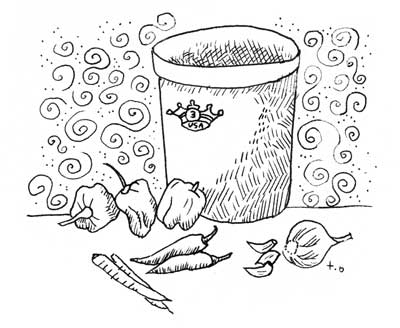 |
| Illustration by Toki Oshima |
By Roberta Bailey
Kimchi, kombucha, sauerkraut, fermented vegetables, kefir, yogurt, sour beers and ciders – live probiotic ferments are all the rage these days. Add hot sauces to that list as well.
As a condiment lover and, particularly, a fan of hot peppers, I am excited. I love the full pepper flavor that is not masked by vinegar. I have been experimenting with fermenting finished sauces and with fermenting combinations of ingredients for future blends. I take notes: Next time more garlic or less onion, more jalapeno and less serrano. What happens if I add apple or cranberry?
Here are some basics. Lacto-fermentation uses a 5 percent salt brine as its base. This brine is salty enough to kill harmful bacteria and allows beneficial Lactobacillus bacteria to thrive. The Lactobacillus organisms begin to convert lactose and other natural sugars in the ingredients into lactic acid, which is the acidic base that preserves the vegetables and gives them their tangy flavor.
For a basic ferment, all you need is a jar, a plastic freezer bag, your select mix of peppers, garlic and sea salt. You can ferment any combination of ingredients in a 5 percent salt brine. To make a brine, dissolve 3 tablespoons of salt in 1 quart of warm, non-chlorinated water. Ferment the ingredients for two weeks to many months. It is important to use sea salt, whether Celtic, Himalayan or plain, and not salt with additives or iodine.
Basic Lacto-Fermented Hot Sauce
Makes 2 cups
Recipe can be cut in half or doubled.
2 c. hot peppers, chopped or sliced into rings
4 to 6 cloves garlic, crushed
2 c. non-chlorinated water
1 Tbsp. sea salt
Place the peppers and garlic in a clean quart mason jar or other suitable glass jar. Heat the water in a saucepan and add the salt. Stir to dissolve. The water does not need to be very hot. Let the solution cool to room temperature. Pour the brine over peppers in the jar.
Place the empty freezer bag in the jar, with the bag mouth open at the top. Press it down so that the peppers below are beneath the brine. Now fill the bag with just enough water to keep the peppers down and to still allow you to put the lid on the jar. This keeps the peppers from rising above the brine and from molding.
Set your jar in a cool place away from direct sunlight. Place a dish below it to catch any brine that may overflow during fermentation.
In two to three days, the brine will begin to look cloudy and to smell a bit sour. If temperatures are cool, this may take a week. Leave the peppers two to three weeks longer to develop more flavor. (Some recipes call for fermenting the peppers for four to eight weeks.)
Drain the brine into a separate jar. Place the peppers in a blender and blend until smooth. Add brine to the peppers to get the desired consistency. You can also just blend half of your pepper mixture and keep the remaining ferment in the fridge for future blends. It will age slowly in the fridge.
You can create a less pulpy sauce by straining it through cheesecloth.
Pour the blended sauce into a clean jar or jars and store in the refrigerator. It is ready to use and will last several months.
Seven Tree Farm Pepper Puree
Yields about 1 quart
1 lb. hot peppers
1/2 lb. sliced carrots
4 cloves garlic
2 tsp. sea salt
one crock or glass jar
1 Ziploc-type freezer bag
Place peppers in a food processor and blend to a coarse chop. Place in a bowl. Blend the garlic and carrots to a smooth puree. Add to the bowl. Mix in the salt. Press the mixture into a clean crock or jar.
Place the empty freezer bag in the jar, with the bag mouth open at the top. Press it down so that the pepper puree is beneath the brine. Now fill the bag with just enough water to keep the puree down and to still allow you to put the lid on the jar or crock. This keeps the puree from rising above the brine that will be created and from molding.
Set the jar in a cool place out of direct sun and allow the ingredients to ferment for three weeks. You may need to put a bowl or baking sheet beneath the jar to catch any overflow. Check regularly to see that the puree is submerged and is not molding. If it is molding, just spoon off the mold and reset your plastic bag to weight the pulp.
This puree can be used after four weeks, but it will continue to develop flavor over three to six months. You can place it in the fridge to slow the process once it has fermented for one month. It will store in the refrigerator for two years or more.
This edition of the Harvest Kitchen was originally published in the winter 2017 issue of The Maine Organic Farmer & Gardener.
Looking for more seasonal recipes? Sign up for MOFGA’s Local and Organic Kitchen Newsletter.
